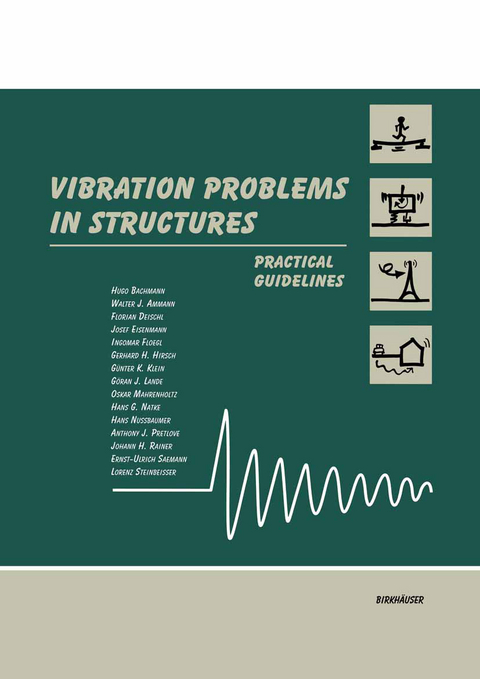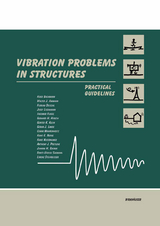Vibration Problems in Structures
Springer Basel (Verlag)
978-3-7643-5148-9 (ISBN)
Bewegungen des menschlichen Körpers
Rotationen, Schwingungen
Windströmungen
Straßenverkehr, Eisenbahnverkehr und Bauarbeiten
Der Hauptteil des Buches bietet Entscheidungshilfen für einfache Lösungen bei häufig vorkommenden Vibrationsproblemen. Schwierigere Probleme und fortschrittlichere Lösungen werden gleichfalls berücksichtigt.
Im Anhang sind die für die Hauptkapitel des Buches wichtigen Grundlagen aufgeführt.
1 Vibrations induced by people.- 1.1 Pedestrian bridges.- 1.2 Floors with walking people.- 1.3 Floors for sport or dance activities.- 1.4 Floors with fixed seating and spectator galleries.- 1.5 High-diving platforms.- References to Chapter 1.- 2 Machinery-induced vibrations.- 2.1 Machine foundations and supports.- 2.2 Bell towers.- 2.3 Structure-borne sound.- 2.4 Ground-transmitted vibrations.- References to Chapter 2.- 3 Wind-induced vibrations.- 3.1 Buildings.- 3.2 Towers.- 3.3 Chimneys and Masts.- 3.4 Guyed Masts.- 3.5 Pylons.- 3.6 Suspension and Cable-Stayed Bridges.- 3.7 Cantilevered Roofs.- References to Chapter 3.- 4 Vibrations induced by traffic and construction activity.- 4.1 Roads.- 4.2 Railways.- 4.3 Bridges.- 4.4 Construction Work.- References to Chapter 4.- A Basic vibration theory and its application to beams and plates.- A.1 Free vibration.- A.2 Forced vibration.- A.3 Harmonic excitation.- A.4 Periodic excitation.- A.4.1 Fourier analysis of the forcing function.- A.4.2 How the Fourier decomposition works.- A.4.3 The Fourier Transform.- A.5 Tuning of a structure.- A.6 Impedance.- A.7 Vibration Isolation (Transmissibility).- A.8 Continuous systems and their equivalent SDOF systems.- B Decibel Scales.- B.1 Sound pressure level.- B.2 Weighting of the sound pressure level.- C Damping.- C.1 Introduction.- C.2 Damping Quantities (Definitions, Interpretations).- C.3 Measurement of damping properties of structures.- C.3.1 Decay curve method.- C.3.2 Bandwidth method.- C.3.3 Conclusions.- C.4 Damping mechanisms in reinforced concrete.- C.5 Overall damping of a structure.- C.5.1 Damping of the bare structure.- C.5.2 Damping by non-structural elements.- C.5.3 Damping by energy radiation to the soil.- C.5.4 Overall damping.- D Tuned vibration absorbers.- D.1 Definition.- D.2 Modelling and differential equations of motion.- D.3 Optimum tuning and optimum damping of the absorber.- D.4 Practical hints.- E Wave Propagation.- E.1 Introduction.- E.2 Wave types and propagation velocities.- E.3 Attenuation laws.- F Behaviour of concrete and steel under dynamic actions.- F.1 Introduction.- F.2 Behaviour of concrete.- F.2.1 Modulus of elasticity.- F.2.2 Compressive strength.- F.2.3 Ultimate strain in compression.- F.2.4 Tensile strength.- F.2.5 Ultimate strain in tension.- F.2.6 Bond between reinforcing steel and concrete.- F.3 Behaviour of reinforcing steel.- F.3.1 Modulus of Elasticity.- F.3.2 Strength in Tension.- F.3.3 Strain in tension.- G Dynamic forces from rhythmical human body motions.- G.1 Rhythmical human body motions.- G.2 Representative types of activity.- G.3 Normalised dynamic forces.- H Dynamic effects from wind.- H.1 Basic theory.- H.l.1 Wind speed and pressure.- H.l.2 Statistical characteristics.- a) Gust spectrum.- b) Aerodynamic admittance function.- c) Spectral density of the wind force.- H.1.3 Dynamic effects.- H.2 Vibrations in along-wind direction induced by gusts.- H.2.1 Spectral methods.- a) Mechanical amplification function.- b) Spectral density of the system response.- H.2.2 Static equivalent force method based on stochastic loading.- H.2.3 Static equivalent force method based on deterministic loading.- H.2.4 Remedial measures.- H.3 Vibrations in along-wind direction induced by buffeting.- H.4 Vibrations in across-wind direction induced by vortex-shedding.- H.4.1 Single structures.- H.4.2 Several structures one behind another.- H.4.3 Conical structures.- H.4.4 Vibrations of shells.- H.5 Vibrations in across-wind direction: Galloping.- H.6 Vibrations in across-wind direction: flutter.- H.7 Damping of high and slenderRC structures subjected to wind.- I Human response to vibrations.- I.1 Introduction.- I.2 Codes of practice.- I.2.1 ISO 2631.- I.2.2 DIN 4150/2.- J Building response to vibrations.- J.1 General.- J.2 Examples of recommended limit values.- References to the Appendices.- List of Codes and Standards.
| Erscheint lt. Verlag | 20.12.1994 |
|---|---|
| Zusatzinfo | XVII, 237 p. |
| Verlagsort | Basel |
| Sprache | englisch |
| Maße | 152 x 229 mm |
| Gewicht | 534 g |
| Themenwelt | Technik ► Bauwesen |
| Technik ► Maschinenbau | |
| Schlagworte | Baukonstruktion • Baustatik • Concrete • DIN • Environment • Fundament • Mann • Natur • Norm • Production • Pylon • quality • reinforced concrete • Schwingung • Service • Structure • Tower • Vibration |
| ISBN-10 | 3-7643-5148-9 / 3764351489 |
| ISBN-13 | 978-3-7643-5148-9 / 9783764351489 |
| Zustand | Neuware |
| Informationen gemäß Produktsicherheitsverordnung (GPSR) | |
| Haben Sie eine Frage zum Produkt? |
aus dem Bereich




